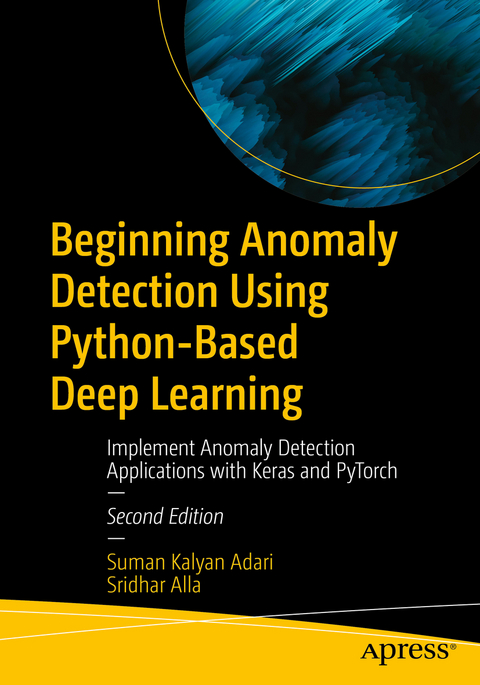
Beginning Anomaly Detection Using Python-Based Deep Learning
Apress (Verlag)
979-8-8688-0007-8 (ISBN)
Beginning Anomaly Detection Using Python-Based Deep Learning begins with an introduction to anomaly detection, its importance, and its applications. It then covers core data science and machine learning modeling concepts before delving into traditional machine learning algorithms such as OC-SVM and Isolation Forest for anomaly detection using scikit-learn. Following this, the authors explain the essentials of machine learning and deep learning, and how to implement multilayer perceptrons for supervised anomaly detection in both Keras and PyTorch. From here, the focus shifts to the applications of deep learning models for anomaly detection, including various types of autoencoders, recurrent neural networks (via LSTM), temporal convolutional networks, and transformers, with the latter three architectures applied to time-series anomaly detection. This edition has a new chapter on GANs (Generative Adversarial Networks), as well as new material covering transformer architecture in the context of time-series anomaly detection.
After completing this book, you will have a thorough understanding of anomaly detection as well as an assortment of methods to approach it in various contexts, including time-series data. Additionally, you will have gained an introduction to scikit-learn, GANs, transformers, Keras, and PyTorch, empowering you to create your own machine learning- or deep learning-based anomaly detectors.
What You Will Learn
Understand what anomaly detection is, why it it is important, and how it is applied
Grasp the core concepts of machine learning.
Master traditional machine learning approaches to anomaly detection using scikit-kearn.
Understand deep learning in Python using Keras and PyTorch
Process data through pandas and evaluate your model's performance using metrics like F1-score, precision, and recall
Apply deep learning to supervised, semi-supervised, and unsupervised anomaly detection tasks for tabular datasets and time series applications
Who This Book Is For
Data scientists and machine learning engineers of all levels of experience interested in learning the basics of deep learning applications in anomaly detection.
Suman Kalyan Adari is a machine learning research engineer. He obtained a B.S. in Computer Science at the University of Florida and a M.S. in Computer Science specializing in Machine Learning at Columbia University. He has been conducting deep learning research in adversarial machine learning since his freshman year at the University of Florida and presented at the IEEE Dependable Systems and Networks workshop on Dependable and Secure Machine Learning held in Portland, Oregon in June 2019. Currently, he works on various anomaly detection tasks spanning behavioral tracking and geospatial trajectory modeling. He is passionate about deep learning, and specializes in various fields ranging from video processing, generative modeling, object tracking, time-series modeling, and more. Sridhar Alla is the co-founder and CTO of Bluewhale, which helps organizations big and small in building AI-driven big data solutions and analytics, as well as SAS2PY, a powerful tool to automate migration of SAS workloads to Python-based environments using Pandas or PySpark. He is a published author and an avid presenter at numerous conferences, including Strata, Hadoop World, and Spark Summit. He also has several patents filed with the US PTO on large-scale computing and distributed systems. He has extensive hands-on experience in several technologies, including Spark, Flink, Hadoop, AWS, Azure, Tensorflow, Cassandra, and others. He spoke on Anomaly Detection Using Deep Learning at Strata SFO in March 2019 and also presented at Strata London in October 2019. He was born in Hyderabad, India and now lives in New Jersey, USA with his wife Rosie, his daughters Evelyn andMadelyn, and his son, Jayson. When he is not busy writing code, he loves to spend time with his family. He also enjoys training, coaching, and organizing meetups.
Chapter 1: Introduction to Anomaly Detection.- Chapter 2: Introduction to Data Science.- Chapter 3: Introduction to Machine Learning.- Chapter 4: Traditional Machine Learning Algorithms. -Chapter 5: Introduction to Deep Learning.- Chapter 6: Autoencoders.- Chapter 7: Generative Adversarial Networks.- Chapter 8 Long Short-Term Memory Models.- Chapter 9: Temporal Convolutional Networks.- Chapter 10: Transformers.- Chapter 11: Practical Use Cases and Future Trends of Anomaly Detection.
| Erscheinungsdatum | 17.01.2024 |
|---|---|
| Zusatzinfo | 582 Illustrations, black and white; XVI, 529 p. 582 illus. |
| Verlagsort | Berlin |
| Sprache | englisch |
| Maße | 178 x 254 mm |
| Themenwelt | Mathematik / Informatik ► Informatik ► Betriebssysteme / Server |
| Mathematik / Informatik ► Informatik ► Programmiersprachen / -werkzeuge | |
| Informatik ► Theorie / Studium ► Künstliche Intelligenz / Robotik | |
| ISBN-13 | 979-8-8688-0007-8 / 9798868800078 |
| Zustand | Neuware |
| Informationen gemäß Produktsicherheitsverordnung (GPSR) | |
| Haben Sie eine Frage zum Produkt? |
aus dem Bereich


